Opening Day provides sampling of Hawaii’s important issues
The activists and members of the public gathered in the rotunda for the opening day of the 2015 legislative session reflected a sampling of the issues and problems most important to those engaged in Hawaii's future.
Yesterday was opening day for the 2015 Hawaii state legislative session, and while the Senators and Representatives in their respective galleries were busy with opening remarks, oaths of office and other ceremonious tasks, the Capitol rotunda was a buzz with activist groups and members of the public.
The Movement for Aloha No ka ʻĀina (MANA) had a large stage set-up on the mauka side of the rotunda on which speeches would be given in the afternoon. Speakers included Indian environmental activist and anti-globalization author Vandana Shiva, Kauai Councilman Gary Hooser, members of Ke Ea Hawaii, the Hawaii Charter Schools student council, the Lawful Hawaiian Government Prime Minister Henry Noa and activist and University of Hawaii (UH) at Manoa Hawaiʻinuiakea School of Hawaiian Knowledge professor Jon Osorio.
Smaller stations manned by activists supporting U.S. army downsizing in Hawaii, opposing the continued selling of ceded lands and hoping to promote small-scale agriculture were scattered throughout.
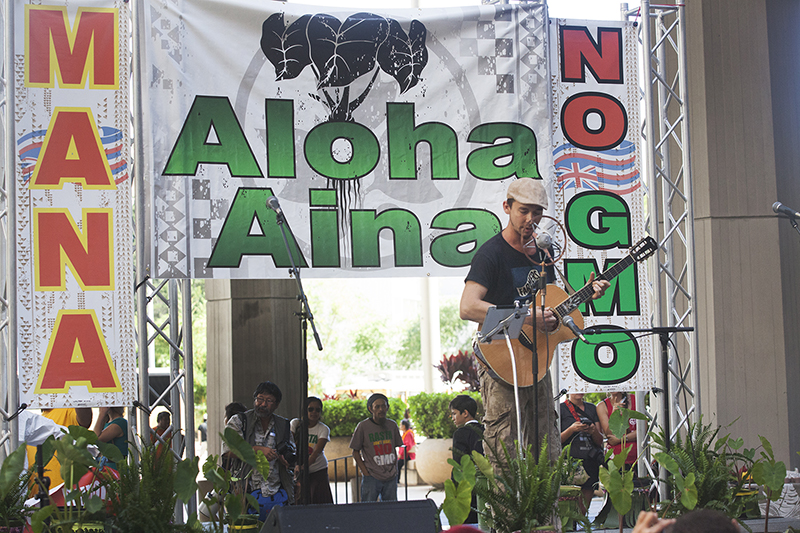
On the makai side of the rotunda, a large group of students from Kamehameha Schools, Punahou and several Charter Schools participated in kuʻi (poi pounding) along with members of the public.
Over by the stage, the Independent met up with Molokai resident and longtime Hawaiian activist Walter Ritte. Ritte acted as one of the masters of ceremonies for the speeches later that afternoon. He told us that, for him, yesterday was about bringing together anti-GMO activists and Native Hawaiian activists in solidarity with one another.
“I’m hoping to build a coalition between Hawaiians and conservation groups, tied by a commitment to aloha ʻāina; to learn to accept each other’s differences [and to come together] to influence lawmakers to protect the land and health of Hawaii,” Ritte said.
With the recent lawsuits filed by the big five agribusiness companies against Maui, Kauai and Hawaii counties (all of which enacted recent ordinances regulating GMOs and/or pesticide use), the question of home rule and county pre-emption by the state could offer the perfect flash point to galvanize those to groups.
“As you can see here, today this is the people’s hale. It’s usually the corporation’s hale,” he said with a smile.
Army downsizing
Over by the poi pounders, we ran into Terri Kekoʻolani and Tina Grandinetti who were manning a petition booth asking for support of the U.S. Department of Defense’s (DOD) proposed downsizing of the military presence in Hawaii. The DOD recommends reducing army personnel by 19,800. They were also spreading the word about an Army Listening Session at the Hale Koa Hotel on January 27 at 6:30 p.m.
“Congress mandated that the army reduce its troops nationwide, so right now the DOD is deciding which bases to take them from,” explained Grandinetti. “The listening session is designed to get an idea of what the opinion in Hawaii is.”
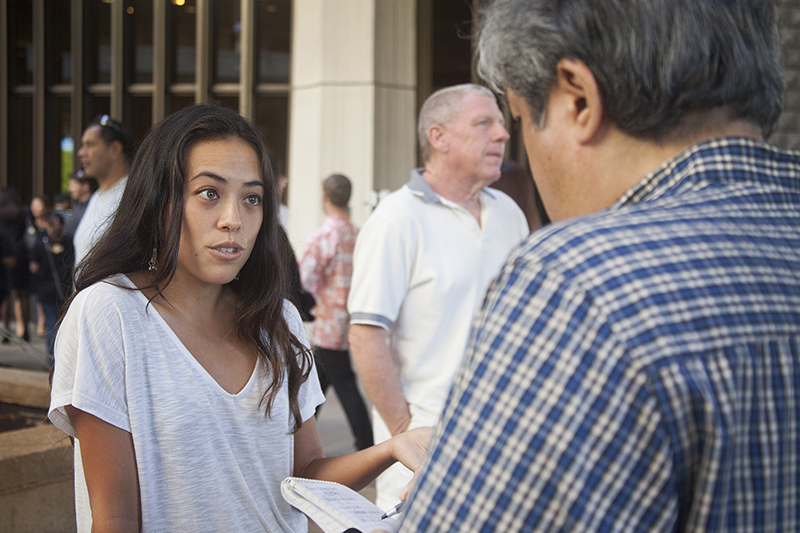
Entities like the Chamber of Commerce of Hawaii, which represents most of the businesses that directly profit from our large military presence, have set up a campaign to convince the DOD that a smaller reduction of 9,000 personnel would be better. They argue that the economic transition resulting from the larger downsize of nearly 20,000 personnel would be too hard for local businesses, and the U.S. congressional delegation appears to agree.
“We acknowledge that the economic transition will be difficult, but if we fight to get the army to help us make the transition, we open up the doors for economic alternatives and we can decrease our dependence on the military,” said Grandinetti.
The pair handed out fliers that made the argument for why the larger reduction ought to be supported. The printed material states that, “this downsizing could bring significant environmental benefits, alleviate our affordable housing problem, and open up economic alternatives to our dependence on the military industry. It is a rare chance to take a big step towards demilitarization and toward building a more pono Hawaii.” (For an honest and encompassing cost-benefit analysis of the U.S. military presence in Hawaii, click here.)
To find out more about the downsizing and the listening session, visit oc4ad.com, the Oahu Council for Army Downsizing. The council’s director, Al Frenzel, is a retired U.S. Army Colonel, and has lived in Hawaii for 40 years. He is a career logistician for the Army and, in his last Army assignment as a faculty member of the Army War College, was lesson author and exercise director for his Department’s curriculum focus on force structuring of the Armed Forces of the United States. In his bio for his guest op-ed column for the Star-Advertiser on Nov. 16, 2014, entitled “Hawaii and nation would do better if Army reducted its footprint here,” Frenzel is described as a former Libertarian candidate for a state House seat.
The Council asks that Schofield Barracks, Wheeler Army Airfield, Makua Valley, Dillingham Military Reservation, and Kolekole Pass (with unimpeded access to Lualualei Naval Road) be returned to the state.
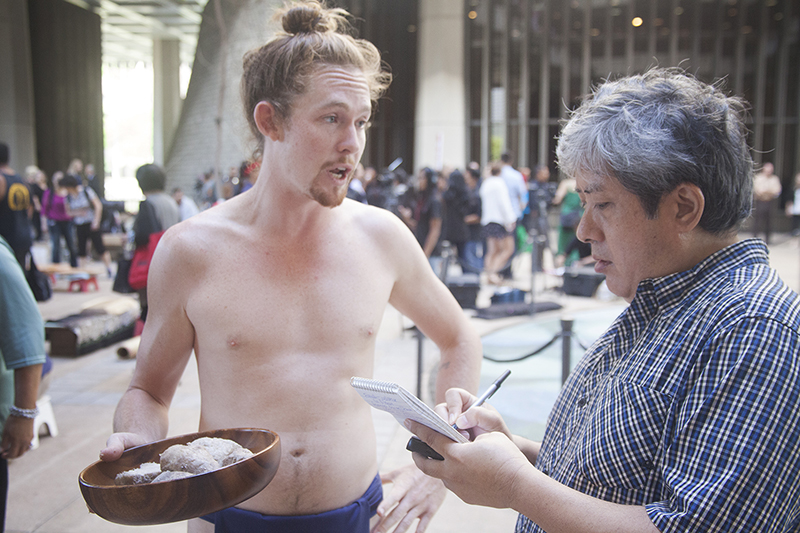
Diversified Ag
We ran into Sean Anderson of Green Rows Farm in Waimanalo as he carried a bowl of freshly harvested kalo root over to the kuʻi boards to be pounded. We asked the young farmer and vice-president of the Hawaii Farmers Union United (HFUU), Oahu Chapter, about the future of agriculture in Hawaii.
“I believe in farming that goes beyond simply growing organic produce,” he told us. “We blend natural farming practices, regenerative soil building and indigenous Hawaiian practices to build biodiversity and resiliency.”
Anderson was at opening day with with Kai Hinson, the HFUU Oahu secretary and Anderson’s partner at Green Rows, who was manning a farming information booth. Anderson told us about the operation at Green Rows. The three-acre farm grows a variety of greens, vegetables, tumeric, ginger, dry-land kalo, and also raises chickens for fresh eggs, which are sold at the farmer’s market in Kailua.
“There are other farmer’s that are also practicing this form of agriculture,” said Anderson. “If you think of it on a scale, we’ve got degenerative on one side, sustainable in the middle, and regenerative on the other side. Regenerative means the soil is getting stronger year after year; the biodiversity is richer and the plants are healthier.”
The Kailua farmer’s market is the only outlet Green Rows uses to sell its produce, but the farm also hosts educational workshops and other events in the hopes of spreading the idea that an agricultural system is much stronger when diversified, and that regenerative farming techniques—many of which come from indigenous techniques of land management and soil building—are a vital part of a healthy future for agriculture in Hawaii.
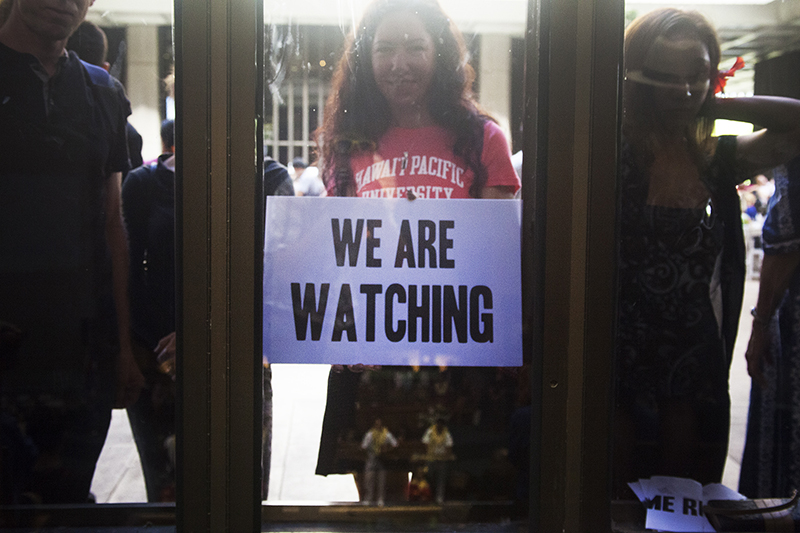
To GMO, or not to GMO
MANA’s main stage was decorated with anti-GMO slogans in addition to Hawaiian self-determination messages, and groups of Kauai and Maui residents dressed in full-body hazard suits complete with gas masks held signs condemning the big five agribusiness companies (DuPont, Syngenta, Dow Agrosciences, Monsanto and BASF) for suing the two counties over recently passed county ordinances restricting pesticide use and the production of genetically modified organisms (GMOs).
As senators and representatives pomped-and-circumstanced through their opening day ceremonies, other protestors held ambiguous white placards outside the galleries with messages such as, “We Are Watching,” “We Care,” and “We Are Here.” These protestors appeared to have been organized by the Center for Food Safety Hawaii, Babes Against Bio-tech and GMO-free Oahu, though not all of the people holding signs were members of those groups.

Doorae Shin, the student sustainability coordinator at the UH Manoa, explained that the protest was meant as a dramatic gesture to let legislators know that the groups opposed to the agribusinesses and their use of GMO fields as testing grounds for chemical pesticides will be watching them this session to see what actions (or lack thereof) they take.
Meanwhile, outside the rotunda, we caught up with Hawaii Crop Improvement Association (HCIA) executive director, Bennette Misalucha, and president, Kirby Kester.
“It’s important to be a participant in the legislative process because we all know how important agriculture is to Hawaii,” said Misalucha. “We want to make sure we provide accurate and scientific information to the community and to the legislators.”
According to its website, HCIA is “a nonprofit trade association representing the agricultural seed industry in Hawaii. HCIA and its members support the growth and development of the seed industry, Hawaii agriculture and agricultural sciences in Hawaii through advocacy, outreach education and science-based information. The companies that constitute HCIA’s membership grow and develop varieties of several seed crops, including corn, soybeans, sunflowers and rice.”
When asked about Ritte’s hopes to galvanize native Hawaiians with the anti-GMO groups who oppose HCIA, Misalucha said: “We may have divergent views, but we need to be respectful of each other. The tone and rhetoric that dominates the discussion right now just makes for long-term pilikia.”
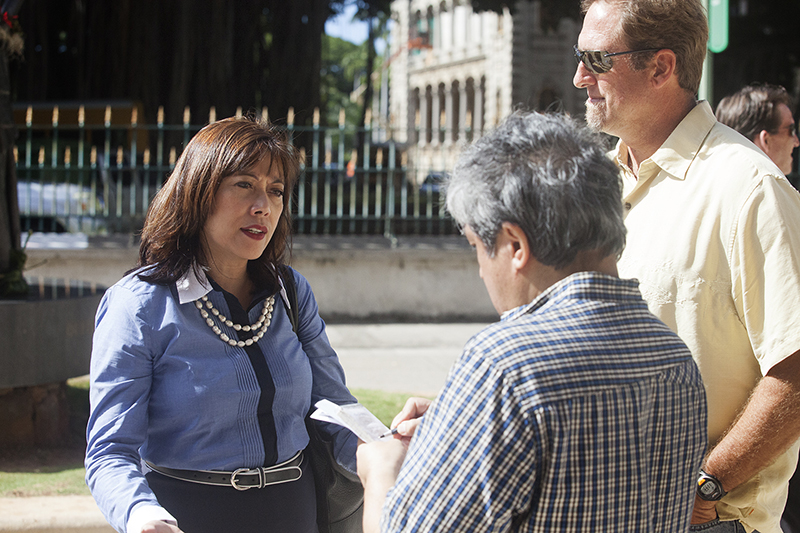
But, Misalucha said, there is common ground to be found. “Both sides share a love for the ʻāina; the farmers are the best stewards of the land,” she said. “Farmers, of all people, recognize that land is a finite resource. They want to make sure we take care of it in such a way that it becomes sustainable.”
Misalucha said she feels like HCIA and the agribusiness companies need to do a better job of educating people about GMOs and about what the agribusiness companies are about. “The onus is one us to continue to educate but, unfortunately, there is a lot of fear-mongering out there and misinformation.
“To this day, a lot of people don’t know where their food comes from,” continued Misalucha. “There’s a certain ignorance involved; 75–80 percent of products you see in the supermarket have some GMO aspect to them.”
Prison reform
Outside the Senate chamber, we stopped to talk with Kat Brady of the Community Alliance on Prisons (CAP). We wanted to know what sort of criminal justice and prison system reform she and other reformers were hoping to pass this session.
CAP—which Brady half-jokes stands for putting a “cap” on the prison population—wrote recommendations to the U.S. Department of Justice (DOJ) for the Justice Reinvestment Initiative (JRI) back in 2011. “I hope this administration actually embraces it, because the prior administration abandoned it,” said Brady. “I’m hoping Governor Ige will acknowledge research and data-driven information.”
Brady says that over the past 20 years, CAP has seen some good things come out of the Legislature, such as parity for female offenders, but Hawaii’s lawmakers still have a lot of work to do.
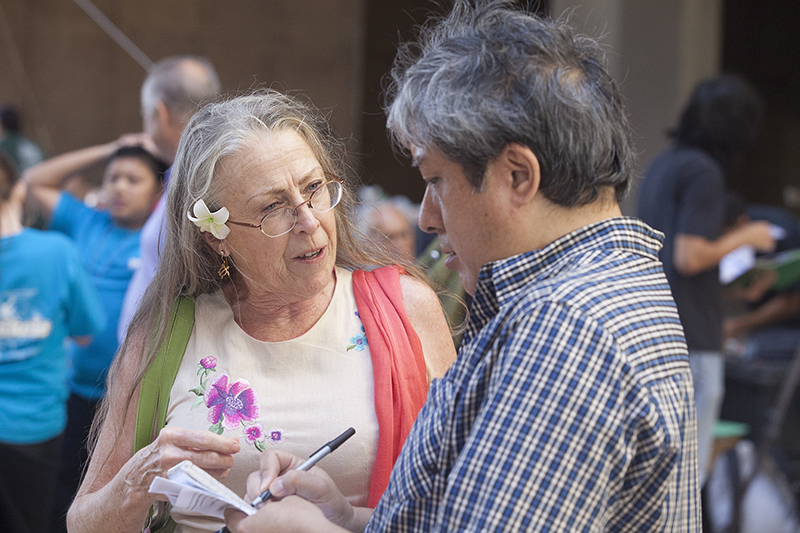
“We need to do something about problems with irregular visitation,” said Brady. “Visitation is so crucial for preventing recidivism and keeping families together.”
Also high on her list is better training for prison guards (who aren’t required to have even a high-school diploma)—particularly psychological training so they can learn how to talk prisoners down from confused states, preventing violence in the process.
“The state needs to take responsibility of the situation with our prisons,” said Brady. “These are our people, whether we like them or not. The state is using a criminal justice strategy for a public health problem—drug use—and it isn’t working. It’s ludicrous and expensive. On top of that, there’s no community healthcare system in place to treat mental health.”
According to Brady, the state estimates that 24 percent of the prison population suffers from a mental health problem, but she believes the number to be much higher. She says 60-70 percent of the prison population is made up of native Hawaiians, and native Hawaiian women make up a larger percentage of the female incarcerated population than their male counterparts do for the male prison population. Many are non-violent and are in prison for drug-related offenses.
“Nobody asks, ‘why are people using drugs in the first place; why do people feel so hopeless that they don’t want to be present’” Brady pointed out. “So that’s something that I keep bringing up. Because we have failed as a society if we have this many people who are trying to zip out.”
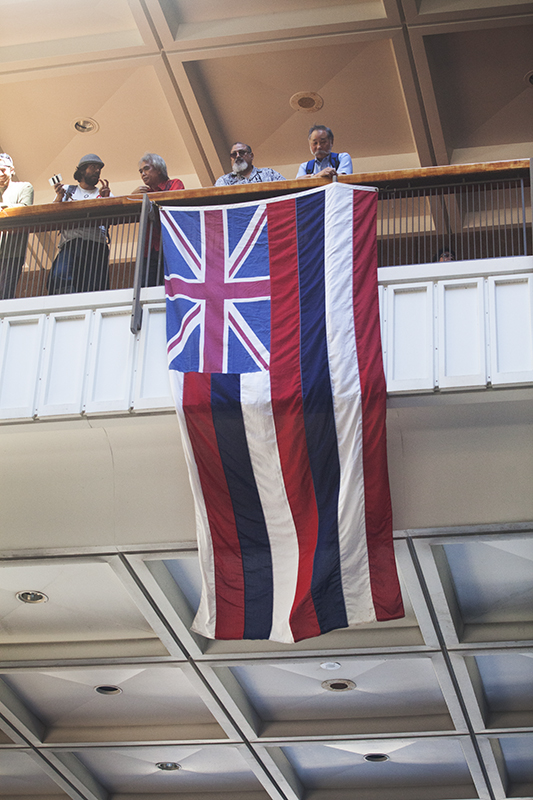
The Hawaiian cultural movement
“To be honest, it’s usually really hard to gauge the Hawaiian cultural movement, but with 300 students and volunteers here today, this is one way to measure that growth,” said Daniel Anthony of Hui Aloha ʻĀina Momona. Anthony was one of the principal organizers for the kuʻi session at the Capitol that day and we talked to him outside the rotunda near Queen Liliʻuokalani’s statue.
“When we did this back in 2011, it was illegal,” comments Anthony. “Back then it was like civil disobedience. Today, it’s actually become a celebration of the legislative process.”
Yesterday was the sixth time ʻĀina Momona had come to kuʻi at the Capitol and with students from Kamehameha Schools, Punahou, Halau Ku Mana, Halau Lokahi, Hakipuʻu Learning Center and UH showcasing their skills in prepping and pounding kalo, the movement is taking root in a younger generation.
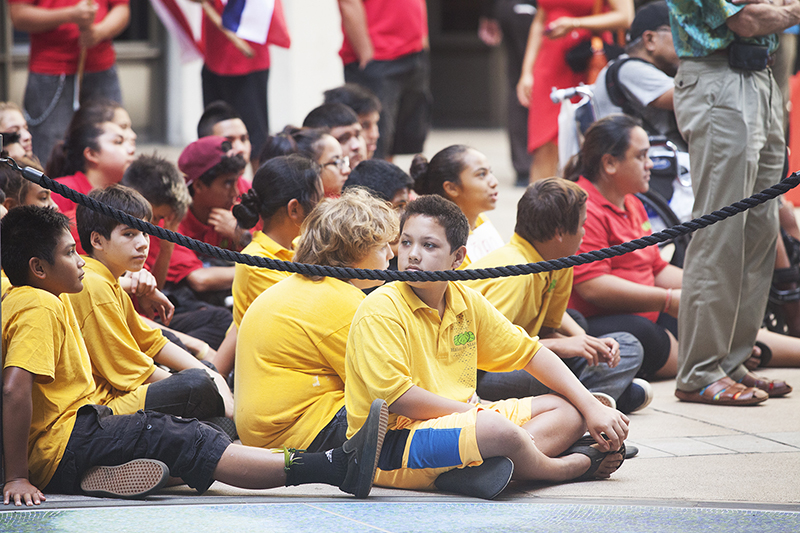
“If we talk about a future political system that is built by active members of the community, this is how we start,” Anthony said. “What the cultural community has yet to be impacted by is policy, because we’re never at the table. But when we show up on day one then, clearly, from day one, you can tell the community owns the rotunda—it’s not politicians, it’s not lobbyists it’s community. And if you really look at who’s here, there are some activists, but mostly it’s active community members.”
For Anthony, kalo symbolically connects the different community members that were at the Capitol yesterday and the issues they care about.
“Kalo encompasses so much,” he said. “People don’t realize it but, at the end of the day, all of these kids bring home this food and feed their families with it. You tell me, what other event at the Capitol has such a direct impact on the dinner tables of a thousand different households?
“What we keep trying to share with our lawmakers is that the concept of your staple is actually the food that holds your community together,” continued Anthony. “Kalo could be that staple, it could be the marquee starch that holds us together, preserves land, protects water, keeps people healthy and lets the culture thrive.”
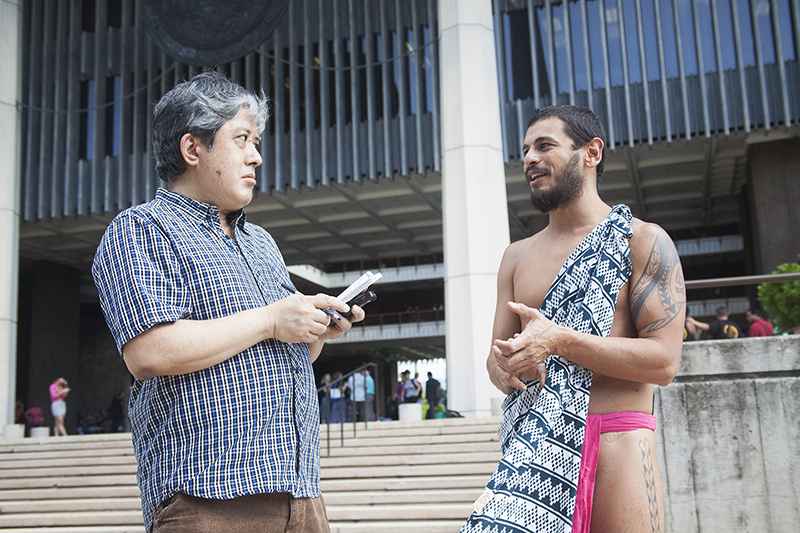
As a parting thought, Anthony told us that his goal was to have students pound poi with Vandana Shiva in the hopes that one of them would be inspired to follow in her footsteps and travel the world educating people on the importance of taking care of our planet.
Just as Anthony finished speaking with us, members of Halau Ku Mana marched into the makai courtyard which is home to the statue of Queen Liliʻuokalani to present a series of ʻoli, demonstrating their commitment to the Hawaiian culture and their investment in their own future and the future of Hawaii (pictures of the ʻoli will be made available shortly).
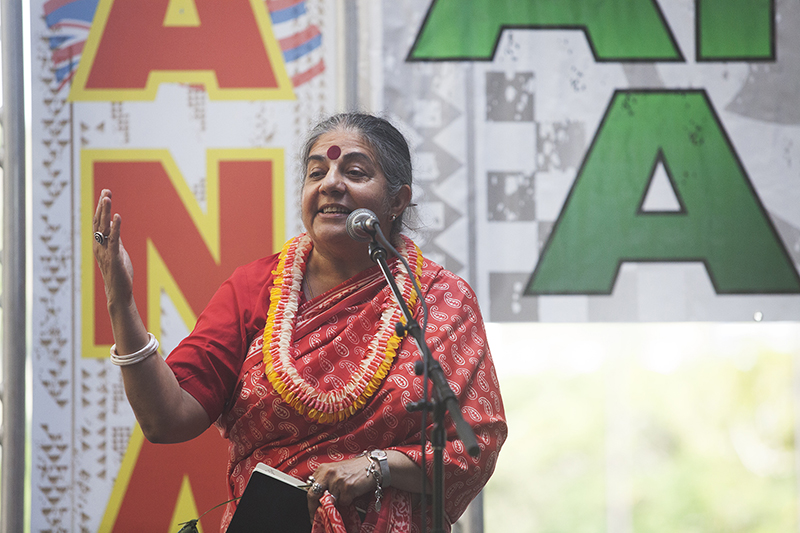
As the day wound down, the main MANA stage became the focal point as the various speakers delivered their speeches in support of the various issues brought forward by the public on opening day. At the same time, KAHEA, the Hawaiian-Environmental Alliance, made its way up the governor’s office on the fifth floor of the Legislature to deliver a request for Governor Ige to intervene on Mauna Kea. Their demands, which include a banning on all future development on the sacred mountain and an outright rejection of UH’s proposed new leases for the summit observatory area, can be read here.
Gary Chun contributed to this report. All photos by Will Caron.
Keep checking Hawaii Independent for updates on these and other important issues that the 2015 session will center around. The Independent will be publishing the majority packages for the House and Senate shortly.
